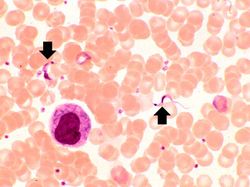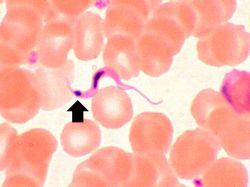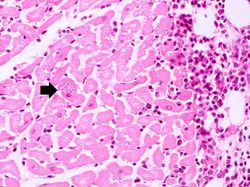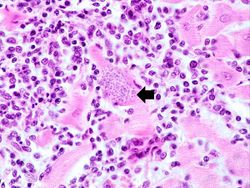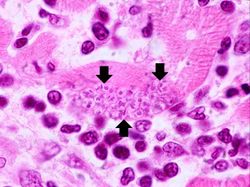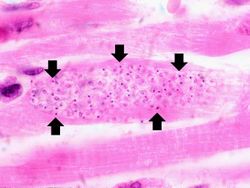Difference between revisions of "IPLab:Lab 11:Chagas Disease"
Seung Park (talk | contribs) |
(→Journal Articles) |
||
| (7 intermediate revisions by one other user not shown) | |||
| Line 11: | Line 11: | ||
File:IPLab11Chagas6.jpg|This is a higher-power photomicrograph of an H & E stained heart biopsy from this patient. Note the T. cruzi amastigotes (arrows) within this longitudinal section of a myocyte. | File:IPLab11Chagas6.jpg|This is a higher-power photomicrograph of an H & E stained heart biopsy from this patient. Note the T. cruzi amastigotes (arrows) within this longitudinal section of a myocyte. | ||
</gallery> | </gallery> | ||
| + | |||
| + | == Virtual Microscopy == | ||
| + | <peir-vm>IPLab11Chagas</peir-vm> | ||
== Study Questions == | == Study Questions == | ||
* <spoiler text="How is Chagas’ disease transmitted?">Reduviid bugs (kissing bugs) bite people while they sleep. The bug defecates on the skin and the infected bug feces is rubbed into the wound. Organisms from the infected feces can also enter the body via mucous membranes. These organisms then circulate via the blood stream to infect cells.</spoiler> | * <spoiler text="How is Chagas’ disease transmitted?">Reduviid bugs (kissing bugs) bite people while they sleep. The bug defecates on the skin and the infected bug feces is rubbed into the wound. Organisms from the infected feces can also enter the body via mucous membranes. These organisms then circulate via the blood stream to infect cells.</spoiler> | ||
* <spoiler text="This patient had acute Chagas' disease. What would you expect to see in a patient with chronic Chagas' disease?">Chronic Chagas' disease leads to congestive heart failure. These patients commonly have right bundle branch block and/or other arrhythmias. These hearts are dilated and hypertrophied, have areas of fibrosis especially in the apex, and often contain mural thrombi. The myocardium is infiltrated with lymphocytes and macrophages and there is interstitial edema and fibrosis. This inflammatory reaction is most severe around the area of the right bundle branch. Patients may also develop megaesophagus and/or megacolon.</spoiler> | * <spoiler text="This patient had acute Chagas' disease. What would you expect to see in a patient with chronic Chagas' disease?">Chronic Chagas' disease leads to congestive heart failure. These patients commonly have right bundle branch block and/or other arrhythmias. These hearts are dilated and hypertrophied, have areas of fibrosis especially in the apex, and often contain mural thrombi. The myocardium is infiltrated with lymphocytes and macrophages and there is interstitial edema and fibrosis. This inflammatory reaction is most severe around the area of the right bundle branch. Patients may also develop megaesophagus and/or megacolon.</spoiler> | ||
| + | |||
| + | == Additional Resources == | ||
| + | === Reference === | ||
| + | * [http://emedicine.medscape.com/article/214581-overview eMedicine Medical Library: Chagas Disease (American Trypanosomiasis)] | ||
| + | * [http://emedicine.medscape.com/article/1000389-overview eMedicine Medical Library: Trypanosomiasis] | ||
| + | * [http://www.merckmanuals.com/professional/infectious_diseases/extraintestinal_protozoa/chagas_disease.html Merck Manual: Chagas Disease] | ||
| + | * [http://www.merckmanuals.com/professional/infectious_diseases/extraintestinal_protozoa/african_trypanosomiasis.html Merck Manual: African Trypanosomiasis] | ||
| + | |||
| + | === Journal Articles === | ||
| + | * Bestetti RB. [http://www.ncbi.nlm.nih.gov/pubmed/11422962 Predictors of unfavourable prognosis in chronic Chagas' disease]. ''Trop Med Int Health'' 2001 Jun;6(6):476-83. | ||
| + | * Calzada JE, Nieto A, Beraún Y, Martín J. [http://www.ncbi.nlm.nih.gov/pubmed/11703822 Chemokine receptor CCR5 polymorphisms and Chagas' disease cardiomyopathy]. ''Tissue Antigens'' 2001 Sep;58(3):154-8. | ||
| + | * Bern C. [http://www.nejm.org/doi/full/10.1056/NEJMra1410150 Chagas’ Disease]. ''NEJM'' 2015 July 30;373:456-466. | ||
| + | |||
| + | === Images === | ||
| + | * [{{SERVER}}/library/index.php?/tags/2166-chagas_disease PEIR Digital Library: Chagas Disease] | ||
{{IPLab 11}} | {{IPLab 11}} | ||
[[Category: IPLab:Lab 11]] | [[Category: IPLab:Lab 11]] | ||
Latest revision as of 14:31, 25 August 2016
Contents
Clinical Summary[edit]
This 12-year-old boy, whose family had recently emigrated from Brazil, presented to the emergency room with a three-day history of malaise, fever, anorexia, and edema of the face and upper extremities. On physical examination the patient had generalized lymphadenopathy and hepatosplenomegaly. The patient was tachycardic and dysgenic with signs of congestive heart failure. A cardiac biopsy was performed which revealed an active myocarditis with leishmanial forms of parasitic organisms within cardiac myocytes. Close examination of peripheral blood smears revealed occasional circulating trypomastigotes. A complement fixation test for antibodies to Trypanosoma cruzi was strongly positive.
Images[edit]
Virtual Microscopy[edit]
Study Questions[edit]
Additional Resources[edit]
Reference[edit]
- eMedicine Medical Library: Chagas Disease (American Trypanosomiasis)
- eMedicine Medical Library: Trypanosomiasis
- Merck Manual: Chagas Disease
- Merck Manual: African Trypanosomiasis
Journal Articles[edit]
- Bestetti RB. Predictors of unfavourable prognosis in chronic Chagas' disease. Trop Med Int Health 2001 Jun;6(6):476-83.
- Calzada JE, Nieto A, Beraún Y, Martín J. Chemokine receptor CCR5 polymorphisms and Chagas' disease cardiomyopathy. Tissue Antigens 2001 Sep;58(3):154-8.
- Bern C. Chagas’ Disease. NEJM 2015 July 30;373:456-466.
Images[edit]
| |||||
Arrhythmias are abnormal heart rhythms.
